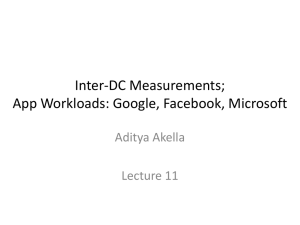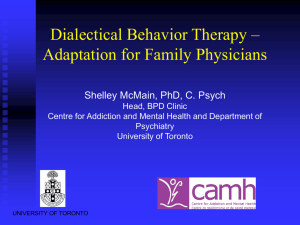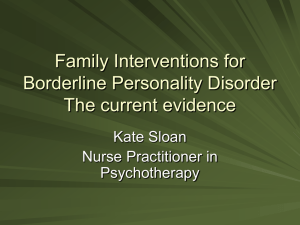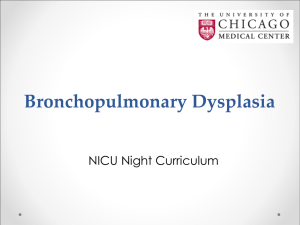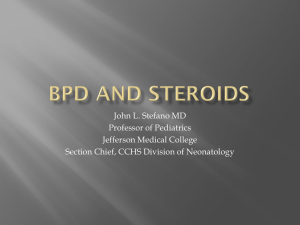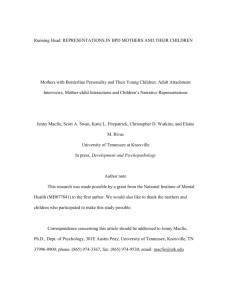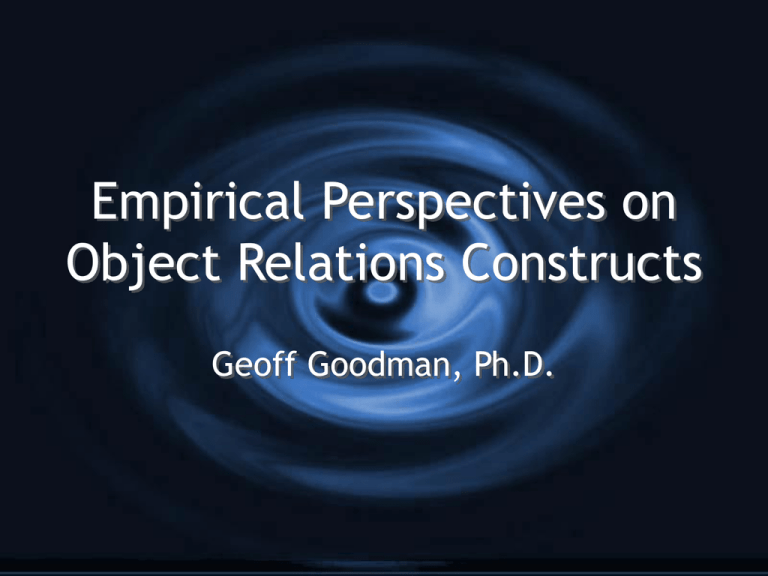
Empirical Perspectives on
Object Relations Constructs
Geoff Goodman, Ph.D.
I. From the Consulting Room to the
Laboratory (Bornstein & Masling)
A. Limitations of clinical evidence
1. personal and professional biases (counter
transference)
a. conscious and deliberate
b. unconscious and unintentional
c. intense, emotional nature of
patient- therapist exchanges
2. self-fulfilling prophecy
a. suggestion by therapist
b. need to gain approval of therapist by
patients
c. patient material therefore supports
therapist’s assumptions
Continued…
B. strengths of clinical evidence
1. hypothesis-- generating
2. experience-- near
C. Purpose of empirical research
1. test hypotheses generated by empirical
research
2. generate hypotheses from results
3. operationalize experience-- distant theory and
make it more relevant to clinical practice
Continued…
D. Contributions of object relations theory
1. object relations concepts (e.g., attachment)
easier to operationalize then classical
psychoanalytic concepts (e.g., drives)
2. object relations theory more accessible to
other disciplines (e.g., developmental
psychology) in focus on concepts such as selfrepresentation
3. importance of reinvigorating psychoanalytic
theory and demonstrating its validity to those
outside the psychoanalytic community
II. Projective Assessment of Object
Relations (Stricker & Gooen-Piels)
A. Conceptual differences among the
measures
1. object relations versus object
representations
2. material to be coded
a. TAT/CAT
b. Rorschach Inkblot Test
c. earliest memories
d. dreams
Continued…
e. unstructured open-ended descriptions of
significant others
f. semi structured interviews
g. responses to clinical vignettes
h. psychotherapy transcriptions (videos)
B. Nature of projective data
1. data that emerge from unconscious
domain
2. variation of undifferentiation and lack
of integration to high differentiation,
integration, and complexity
C. Rorschach data
1. Developmental Analysis of the Concept of
the Object Scale (DACOS)-- 3 dimensions
a. differentiation-- full or part human
b. articulation-- quality of attributions
(physical/ functional)
c. integration-- action interval, integrated with
object, integrated interaction with another
object
d. makes diagnostic distinctions
e. measures therapeutic response
2. Mutuality of Autonomy
Scale (MOAS)
a. interaction of human, animal or
b.
c.
d.
e.
inanimate percepts developing
toward separation- individuation
7-point scale
makes diagnostic distinctions
predicts future functioning
predicts self- mutilating from nonmutilating BPD
D. TAT data
1. Social Cognition and Object Relations Scale
(SCORS)-- 4 dimensions
a. Complexity of Representations of
People
b. Affect tone of relationship paradigms
c. Capacity for emotional investment in
relationships and moral standards (later
split into 2 dimensions)
d. understanding of social causality (like
RF)
e. 5-point scales
Continued…
f. developmentally based except for affect
tone
g. dominant interpersonal concerns added
in 2001 for content assessment
h. makes diagnostic distinctions
i. predicts current functioning
j. associated with childhood experiences
2. other coding systems for TAT not developed
from an object relations perspective
E. Dream data
1. Krohn Object Representation Scale
for Dreams (ORSD)
a. complete, differentiated, alive
b.
c.
d.
e.
developing from primary narcissism to
empathic object relatedness
8- point scale
makes diagnostic distinctions
predicts supervisor-- therapist ratings
predicts clinical improvement
Continued…
f. predicts therapeutic alliance
g. predicts ratings of physical health
2. other coding systems for dream data not
developed from an object relations
perspective
F. Early memories data
1. Early Memories Test (EMT)
a. interview involving 16 queries
b. distinguishes between sex abuse
history from non-sex abuse history
c. makes diagnostic distinctions
2. Comprehensive Early Memories
Scoring System (CEMSS)
a. 9 categories, one of which is object
relations
b. 5 subcategories of object relations
1) perception of others
2) perception of self
3) perception of environment
4) individual distinctiveness
5) degree of interpersonal contact
Continued…
c. 3-point scales
d. makes diagnostic distinctions
e. associated with severity of
psychopathology
G. Parental/ significant other/
therapist/ self representations
1. Object Representations Inventory (ORI)
a. 12 scorable attributes on 7-point scales
b. degree of ambivalence on 9-point scale
c. conceptual level on 9-point scale
d. open-ended descriptions of significant
others
e. makes diagnostic distinctions
f. predicts clinical improvement
g. predicts adaptive coping
h. distinguishes secure from insecure
adults
2. DifferentiationRelatedness Scale (DRS)
a. differentiation-- relatedness as
present in descriptions of self and
others
b. 10-point scale
c. distinguishes secure from insecure
adults
d. predicts clinical improvement
III. Object Relations Research
on Borderline Patients
A. Examination of Rorschach responses
1. BPD patients more malevolent than
psychotic patients
2. BPD patients cognitively advanced
object representations than psychotic
patients and normal controls
3. affect tone not developmental construct
4. BPD patients not necessarily
preoedipally fixated
B. Examination of TAT responses
1. BPD patients lower on affect tone,
emotional investment, social causality,
and complexity than depressed patients
and normal controls
2. some BPD patients produced a number of
complex representations
3. BPD adults higher on complexity,
emotional investment, and social causality
then BPD adolescents
4. risk factors < age 5 were predictive of
object relations scores but not > age 5
Continued…
5. maternal variables were predictive of
object relations scores but not paternal
variables
C. Examination of early memories
1. patients with sex abuse history had more early
memories of personal injury or damage than
those without
2. patients with physical abuse history had more
early memories lacking effective “helpers”

